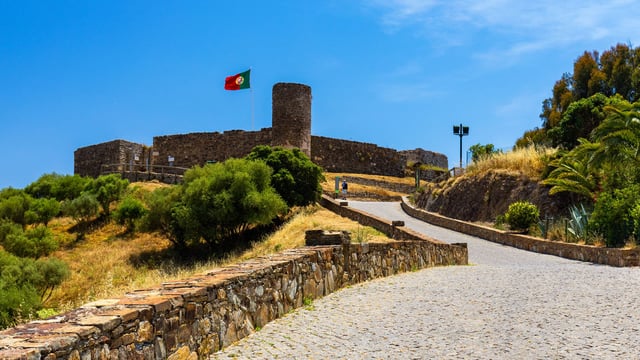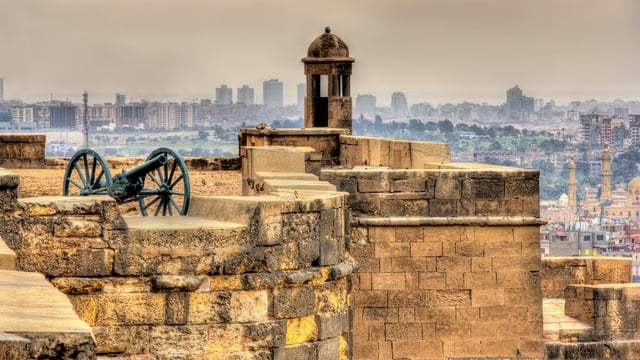- Pedro Alves
- Last Checked and/or Updated 15 December 2021
- No Comments
- Algarve
The hilltop, which overlooks a small town of Aljezur, was occupied throughout prehistory from at least 4000 BC, and then successively and uninterrupted into the Medieval period. An Iron Age tribe known as the Conii built a castrum here, to which the Romans added a watchtower. By the 7th century the Visigoths used the settlement as a fortified site to control traffic on the river.
Muslims settled in the area at the beginning of the 10th century, building on top of previous structures and reshaping the settlement into a typical Moorish castle over the following centuries. During the Taifa and Almohad eras the castle was a part of the defensive line of Silves. And it is from these campaigns, that the current walls and towers date from. More specifically the Almohad period of the the 12th and 13th centuries.
Main Facts & Features
Aljezur comes from the Arabic name for the nearby river.
Period Córdoba Caliphate and Almohad
Architectural Features walls, towers and remnants of a barbican, and the 10th century cistern
Size 0,3 hectares
Timeline: a Brief History of Aljezur Castle
8th century BC The hilltop was occupied by an Iron Age tribe.
1st to 4th century AD Romans occupied the ‘castro’ – adding a watchtower.
6th to 7th century AD Visigoths occupied the hill, perhaps building a simple wall.
10th Century AD Muslims settled the region, founded a village here, and erected an early Medieval ‘hisn’.
12th to 13th century AD The Almohads built the castle layout we see today.
1246 Aljezur is captured by Paio Peres Correia and his Knights of Santiago.
1448 During a visit by members of the Order of Santiago, the castle is referred as being abandoned, at the same time prohibiting the removal of rock and masonry from the site for other constructions.
1755 An earthquake destroyed all the houses inside the walls. Only the nave and presbytery of the church survived.
1940 – 1941 For the commemorations of the Portuguese 8th centenary, the walls were partially reconstructed.
21 November 1996 CMA of Aljezur issued a public tender to reconstruct, preserve and consolidate the remains of the Castle.
2004 to 2008 Further surveys and archaeological excavations were carried out to understand better the different phases of occupation. Islamic period coins were recovered, as well as stone that suggest houses were built outside the fortress walls as well.
What is There to See at Aljezur Castle
A fortress with an irregular, polygonal outline. A round tower was constructed at the northern most point of the castle, and a square tower was placed at the southern tip of the walls.
From the earliest period of the castle only the cistern (aljibe) survives. It has a cube-vault shape, and is accessed through an arched door. It is directly opposite the main entrance gate to the fortress.
Where is Aljezur Castle?
The fortress overlooks the small town of Aljezur on the Aljezur River. The town is on the western coast of the Algarve, within the Southwest Alentejo and St. Vincent Coast Nature Park, less than 10 kms inland from the sea. From north to south, Odeceixe to Carrapateira, the municipality is a mix characterised by important archaeological sites and cultural landscapes, windmills and museums, historical and cultural trails and recreational circuits, as well as BTT bike trails. The coastline has over 40 kilometres of natural beaches from Odeceixe to Amado, an area known for its favourable surfing conditions.
Visiting Aljezur Castle
Visiting the castle is included in the Rota Vicentina hiking and biking tours.
Opening Hours
The site is accessible daily.
Ticket Prices
Free.
How to get to Aljezur Castle
Bus: Expresso regional and national connections from Lisbon, Porto or Coimbra to the village. Eva buses from other locations in Algarve.
Train: Intercidades to Lagos.
Tourist bus: Algarve-Trips, stops at Aljezur and the remaining trip on foot.
Car: A2 highway at 104km take exit 9 to Grândola. At the roundabout, take the IC4 road towards Sines. Afterwards the N120 to Aljezur. Leaving Faro, take the A2 (Via do Infante) until the end (in Bensafrim – Lagos) and the N120 to Aljezur.
More things to See in Aljezur
Municipal Market: Located near the bridge, this small, covered market is a great place to buy fresh fruit and vegetables, cured meats and locally caught seafood.
The ‘Ribat’ of Arrifana: A boardwalk leads through the remnants of an Islamic isolated monastery. Largely wiped out by the tsunami following the 1755 earthquake. It was rebuilt several times before being abandoned in the early 19th century.
Aljezur has four museums that are well worth visiting – one ticket includes admission to all four museums. Half a day will be enough time to visit all four museums.
Municipal Museum of Aljezur
A small but interesting museum with three permanent exhibitions. On the lower level one room displays archaeological artefacts from the Stone Age to the 16th century. A second room focuses on the Islamic period, with a good selection of locally produced ceramics. The upper level is a typical ethnographic collections of local artefacts of historical interest, with everything from clocks to carts.
Aljezur Museum of Sacred Art – Museum De Arte Sacra
Built in the 16th century and also damaged in the 1755 earthquake, the modest, single-naved Igreja da Misericórdia church was reconstructed in the later 18th century (despite the date on the entrance recording the date of the first church). To the rear of the church, in what was a home for the elderly (Hospital da Misericórdia), is a small religious art museum. Most of the objects were donated to the church by a local Monsignor, Manuel Francisco Pardal (1896-1979). Most of the objects are arranged in display cases that are arranged according to the Catholic’s sacred calendar. Do not miss the old church bell and a 14th century crown. If you visit the museum first the security guard will open the church for you.
José Cercas House-museum
This quaint house belonged to Portuguese painter José Cercas (1914–92) who left his home and belongings – a collection of furniture, artworks and personal objects – to the town. Ask at the Municipal Museum for entry.
Antoniano Museum
Housed in a 17th century chapel (also destroyed in the 1755 earthquake), this museum devoted to St Anthony and has various displays of paintings, books, coins and icons.






